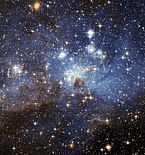| Star formation |
|---|
 |
| Object classes |
| Theoretical concepts |
| This article needs additional citations for verification. Please help improve this article by adding citations to reliable sources. Unsourced material may be challenged and removed. Find sources: "Pre-main-sequence star" – news · newspapers · books · scholar · JSTOR (August 2014) (Learn how and when to remove this message) |
A pre-main-sequence star (also known as a PMS star and PMS object) is a star in the stage when it has not yet reached the main sequence. Earlier in its life, the object is a protostar that grows by acquiring mass from its surrounding envelope of interstellar dust and gas. After the protostar blows away this envelope, it is optically visible, and appears on the stellar birthline in the Hertzsprung-Russell diagram. At this point, the star has acquired nearly all of its mass but has not yet started hydrogen burning (i.e. nuclear fusion of hydrogen). The star continues to contract, its internal temperature rising until it begins hydrogen burning on the zero age main sequence. This period of contraction is the pre-main sequence stage. An observed PMS object can either be a T Tauri star, if it has fewer than 2 solar masses (M☉), or else a Herbig Ae/Be star, if it has 2 to 8 M☉. Yet more massive stars have no pre-main-sequence stage because they contract too quickly as protostars. By the time they become visible, the hydrogen in their centers is already fusing and they are main-sequence objects.
The energy source of PMS objects is gravitational contraction, as opposed to hydrogen burning in main-sequence stars. In the Hertzsprung–Russell diagram, pre-main-sequence stars with more than 0.5 M☉ first move vertically downward along Hayashi tracks, then leftward and horizontally along Henyey tracks, until they finally halt at the main sequence. Pre-main-sequence stars with less than 0.5 M☉ contract vertically along the Hayashi track for their entire evolution.
PMS stars can be differentiated empirically from main-sequence stars by using stellar spectra to measure their surface gravity. A PMS object has a larger radius than a main-sequence star with the same stellar mass and thus has a lower surface gravity. Although they are optically visible, PMS objects are rare relative to those on the main sequence, because their contraction lasts for only 1 percent of the time required for hydrogen fusion. During the early portion of the PMS stage, most stars have circumstellar disks, which are the sites of planet formation.
See also
References
- Richard B. Larson (10 September 2003). "The physics of star formation" (PDF). Reports on Progress in Physics. 66 (10): 1669–1673. arXiv:astro-ph/0306595. Bibcode:2003RPPh...66.1651L. doi:10.1088/0034-4885/66/10/r03. S2CID 18104309.
- Neil F. Comins; William J. Kaufmann III (2011). Discovering the Universe. p. 350. ISBN 978-1-4292-5520-2.
- Derek Ward-Thompson; Anthony P. Whitworth (2011). An Introduction to Star Formation. Cambridge University Press. p. 119. ISBN 978-1-107-62746-8.
- Stahler, S. W.; Palla, F. (2004). The Formation of Stars. Weinheim: Wiley-VCH. ISBN 978-3-527-40559-6.
| Stars | |||||||
|---|---|---|---|---|---|---|---|
| Formation | |||||||
| Evolution | |||||||
| Classification |
| ||||||
| Nucleosynthesis | |||||||
| Structure | |||||||
| Properties | |||||||
| Star systems | |||||||
| Earth-centric observations | |||||||
| Lists | |||||||
| Related | |||||||
| Star formation | ||
|---|---|---|
| Object classes |  | |
| Theoretical concepts | ||
| ||